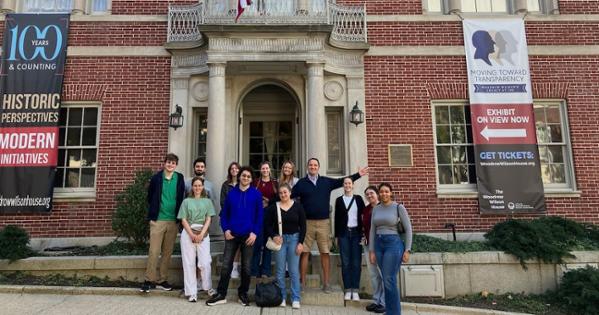Great War Artifacts at the Wilson House Museum

On Saturday, October 26, 2024, The Carmel Institute organized a trip to the Woodrow Wilson House in Washington’s Kalorama neighborhood. Tour guide Luke Stone and Professor Fedyashin gave the students a 60-minute tour of the house during which they explained how Wilson and Lenin, who never met, became existentially connected due to the maelstrom of the Great War.
This year marks the hundredth anniversary of both men’s death within weeks of each other. And in April of 1917, Wilson and Lenin articulated two competing messianic and universalist visions for a new world order. This tectonic shift in geopolitical thinking marked the rise of ideologically driven foreign policy. The two visions emerged simultaneously from the extreme edges of Western civilization—Russia and the US. Born as palliatives during the unprecedented bloodletting of the Great War, the new visions aimed not only to save Europe from itself, but the rest of the world from Europe. In other words, both visions aimed to upend the established world order. Although they had little in common, Wilson and Lenin shared one similarity—they saw themselves as revolutionaries in the realm of diplomacy and geopolitics.
Without the February Revolution of 1917 ushering in a post-autocratic regime in Russia, Wilson’s claim that the US entry into the war would “make the world safe for democracy” would have made little sense. In his famous speech before a joint session of Congress on April 2, 1917, the US President reinterpreted the Great War as a struggle of “free and self-governed peoples” against “selfish and autocratic power.” No European leader thought in those terms in August of 1914 when mobilization enjoyed widespread popular support rooted in a tangle of patriotic, nationalist, imperialist, and dynastic loyalties.
Wilson made the fundamental assumption that has guided American foreign policy ever since—that democracies would never fight each other. Wilson’s point was clear—an American-led world order would break with the European tradition of backroom deals, secret treaties, and espionage. Transparency would become the fabric of a new, liberal world order.
Two weeks after Wilson’s speech, Lenin arrived at the Finland Station in Petrograd and gave a speech that contained his famous “April Theses” which exposed the Great War as “a predatory imperialist” conflict fueled by “the capitalist nature” of bourgeois governments. Lenin saw the conflict as a catalyst for a series of revolutions that would lead to “a new International” of direct worker and peasant democracies. Like Wilson’s, the Bolshevik vision also contained the millenarian promise of a future golden age. Lenin treated internationalism as an integral component of socialism, and he expected the spread of revolution to ensure global peace. The age of ideology in international relations began not with one message, but two competing visions.
In a move anticipating the Wikileaks revelations, the Bolsheviks decided to discredit European diplomacy by publishing the secret negotiations and agreements between the Russia Empire and its Western allies. Seeking peace without contributions and annexations, Lenin envisioned a transparent revolutionary world order beyond traditional European diplomacy. His utopian vision foresaw the dissolution of government structures altogether.
Articulated within days of each other, Lenin’s and Wilson’s messianic visions aimed to de-Europeanize global geopolitics after three centuries of the Old World’s dominance. One knows a systemic crisis when alternatives arise from geographic and political extremes. Aiming to overcome the geopolitical legacy of the “long nineteenth century,” these visions assumed that a peaceful new world order could only result from a proliferation of ideologically similar regimes. A competitive symbiosis would define the fate of the world for the rest of the century as the US and USSR engaged in a competition for the soul of humanity.
Museum visits, concert attendance, and class-trips have been part of the Carmel Institute’s programming since its inception. As Professor Fedyashin has always reminded his students, although our knowledge about the past depends primarily on reading, history must also be walked, seen, touched, smelled, and tasted. The visit to one of Washington’s best hidden museums was a visual component of a holistic experience that stays with students of history for much longer. After the tour, the group went to lunch to discuss their learning.